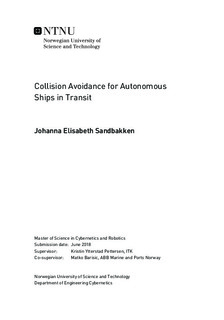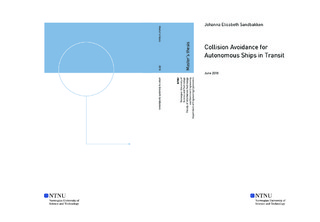| dc.contributor.advisor | Pettersen, Kristin Ytterstad | |
| dc.contributor.advisor | Barisic, Matko | |
| dc.contributor.author | Sandbakken, Johanna Elisabeth | |
| dc.date.accessioned | 2018-08-15T14:02:00Z | |
| dc.date.available | 2018-08-15T14:02:00Z | |
| dc.date.created | 2018-06-25 | |
| dc.date.issued | 2018 | |
| dc.identifier | ntnudaim:18627 | |
| dc.identifier.uri | http://hdl.handle.net/11250/2558186 | |
| dc.description.abstract | The interest in fully autonomous marine vessels has exploded in the last years. Many companies have developed and tested systems for autonomous marine vessels with great success. This thesis is part of a project where the goal is to develop a control system for large, autonomous marine vessels. The focus points in this thesis are collision avoidance and to follow the rules for travelling at sea by the International Regulations for Preventing Collision at Sea (COLREGS). The three main scenarios for collision avoidance is overtaking, head-on and crossing situations between the controlled ship and other ships. The essential thing when controlling a large vessel is to take early action. It secures minimal alternating of the heading and the speed, actions that for a large vessel is highly power consuming.
In this thesis, both the Velocity Obstacle and the Virtual Potential Framework are tested as possible collision avoidance methods. Simulations of the three COLREGS situations mentioned above shows that the implemented systems manage to comply with the COLREGS rules and keep the desired safety distance to the obstacle ships. Problems regarding the two methods are highlighted and discussed, and suggestions for further development are given. | |
| dc.language | eng | |
| dc.publisher | NTNU | |
| dc.subject | Kybernetikk og robotikk, Autonome systemer | |
| dc.title | Collision Avoidance for Autonomous Ships in Transit | |
| dc.type | Master thesis | |

